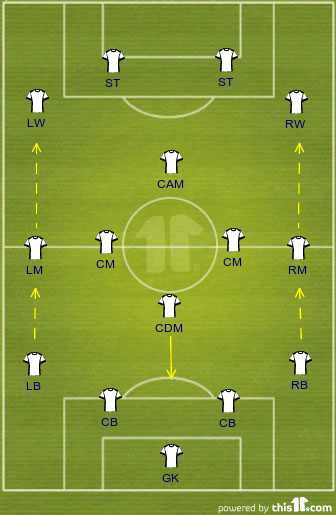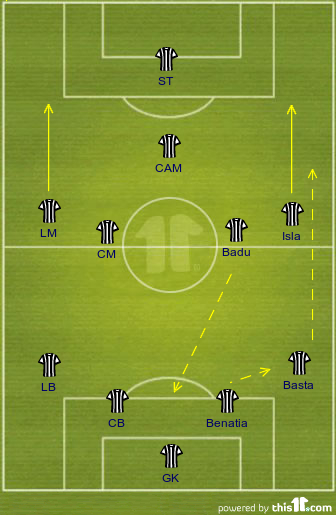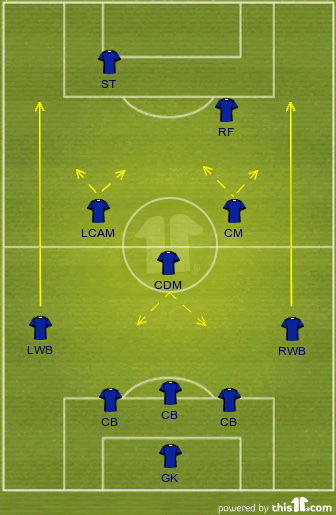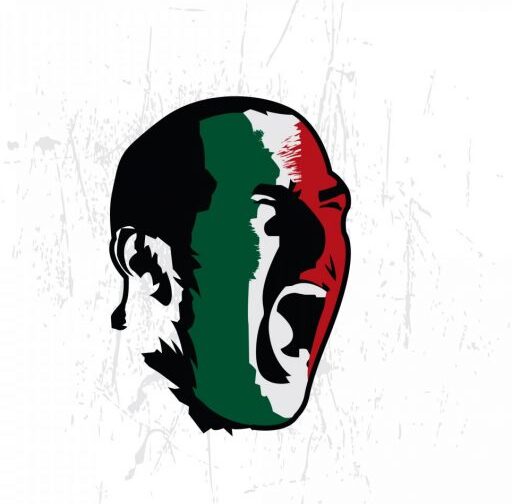 We have seen a lot of great football so far this Serie A season but three teams stand out from the lot for both the similarities and nuances of their styles. The three teams in question are Lazio, Napoli, and Udinese. The common thread between them is the counter-attacking strategy they all employ. However they all go about it differently and it is what has made Serie A so fresh and exciting this year.
We have seen a lot of great football so far this Serie A season but three teams stand out from the lot for both the similarities and nuances of their styles. The three teams in question are Lazio, Napoli, and Udinese. The common thread between them is the counter-attacking strategy they all employ. However they all go about it differently and it is what has made Serie A so fresh and exciting this year.
I guess we should first understand counter-attacking as a tactical strategy that is based on winning the ball from the opposition and breaking at pace towards goal, usually through a minimum amount of passes necessary to create a goal-scoring chance for the forwards. The counter-attacking strategy is usually thought of as a weapon of the weak and presumes that a team sits deep and absorbs pressure before springing forward, and thus often leading to the much-maligned “1 nil” win.
However it is not always the case. A counter-attacking team can press high up the pitch in order to win the ball closer to the opposition penalty area and thus minimize the amount of space it has to cover. Furthermore, it is not necessarily only the technically deficient teams who employ counter-attacking strategies. Playing the counter-attack is simply a choice to get the ball forward quickly by overriding the midfield, where that zone could boast of very good technicians regardless.
 With that being clear now we can appreciate the intricacies of the different counter-attacking styles of the three teams we mentioned. First up are Edy Reja’s men. The Italian tactician shifts his set up from playing either three-at-the-back or five-at-the-back. Although the formation is set up with two center-backs, the defensive midfield plays so deep that he could easily be considered an auxiliary center-back. The switch [from three to five defenders] depends on the situation (playing home or away for instance) and the opposition’s behavior. The use of his fullbacks is the key behind Reja’s counter-attacking strategy and their positioning on the field dictates how the team plays [or even how it is able to play].
With that being clear now we can appreciate the intricacies of the different counter-attacking styles of the three teams we mentioned. First up are Edy Reja’s men. The Italian tactician shifts his set up from playing either three-at-the-back or five-at-the-back. Although the formation is set up with two center-backs, the defensive midfield plays so deep that he could easily be considered an auxiliary center-back. The switch [from three to five defenders] depends on the situation (playing home or away for instance) and the opposition’s behavior. The use of his fullbacks is the key behind Reja’s counter-attacking strategy and their positioning on the field dictates how the team plays [or even how it is able to play].
The fullbacks start deeper when the team is absorbing pressure and usually when Lazio are leading. It is also the default set-up most often used until Reja decides to switch things up depending on how the game is going. The fullbacks are instructed to move further up in midfield when Lazio is getting overrun in that area as well as to offer a quick out-ball when the midfielders win the ball back. At the same time the fullbacks also move higher up the pitch to present a threat whenever the opposition looks to exploit Lazio in the wide areas.
Finally the particularity of Lazio’s fullbacks is in their movement during the transition from the defensive phase to the attacking one (i.e. the counter-attack). When Lazio win the ball back, the fullbacks offer the out-ball by moving into midfield and then continue their run further up the pitch in order to receive the ball and then cross it in for either Miroslav Klose or Tommaso Rocchi. In other words they go from being fullbacks, to wide midfielders, to becoming wide forwards at the end of the move. What this translates is that they operate as relays for the rest of the team. More interestingly is the fact that Reja’s fullbacks seem to actually be the reference points in this tactical system, which is counter-intuitive to the reference point(s) traditionally being through the middle.
 Let’s now move on to Udinese whose counter-attacking style has changed since the departures of Alexis Sanchez, Gokhan Inler, and Cristian Zapata. The Columbian leaving changed Francesco Guidolin’s formation in that he now plays a four-men backline [in a 4-4-2] as opposed to the three-man backline [in a 3-5-2] the Zebrette employed last year, despite appearances. The losses of Inler in midfield and Sanchez in attack have also robbed Udinese of that technical touch they boasted of last year when counter-attacking. These losses have changed the emphasis – but not the style – of Udinese when they counter-attack.
Let’s now move on to Udinese whose counter-attacking style has changed since the departures of Alexis Sanchez, Gokhan Inler, and Cristian Zapata. The Columbian leaving changed Francesco Guidolin’s formation in that he now plays a four-men backline [in a 4-4-2] as opposed to the three-man backline [in a 3-5-2] the Zebrette employed last year, despite appearances. The losses of Inler in midfield and Sanchez in attack have also robbed Udinese of that technical touch they boasted of last year when counter-attacking. These losses have changed the emphasis – but not the style – of Udinese when they counter-attack.
The team still sits deep and deploys the likes or Pablo Armero and Mauricio Isla as their main outlets to get the ball forward. The focal point of the attack is still talismanic captain, Antonio Di Natale. However the midfield duo, of Kwadwo Asamoah and Emmanuel Agyemang–Badu, is a much more physical and athletic one now and the team plays much more on the physical impact those two can offer in winning the ball back. The important player [tactically] is Dusan Basta who plays more conservative and starts deeper in a right-back position, which adds the fourth defender to allow Mehdi Benatia and Danilo to play more centrally.
The position and role of Isla are more as winger this year with Basta sometimes going on the overlap [ during the transition and at which point Badu slots back as a third center-back and Benatia covers the wider area vacated by Basta]. Giampiero Pinzi also holds a more important role in spraying the ball wide [to the onrushing Armero or Isla] or ahead [to Di Natale]. Distribution of the ball is where Udinese’s counter-attack is unique from the others’ as well in that the players – namely Armero and Isla – attack the space. In other words they don’t pile forward as the Lazio fullbacks would but allow Di Natale to create space for them to run into when the ball is played.
The efficacy of this strategy is that it allows the team to remain compact and not get caught flat-footed – since the majority of the block has not moved too far away from their initial positions – should passes get intercepted and Udinese be subject to counter of their own.
 Finally we arrive to Napoli. The Neapolitans are a bit of mix of the two sides aforementioned. Gokhan Inler does a lot of the good things he used to for Udinese, that is to say being the launch pad for most of the Neapolitans’ counter-attacks. Christian Maggio operates in the same manner as Armero and Isla do in carrying the ball forward as well as becoming an auxiliary attacker just as we mentioned it in Reja’s system.
Finally we arrive to Napoli. The Neapolitans are a bit of mix of the two sides aforementioned. Gokhan Inler does a lot of the good things he used to for Udinese, that is to say being the launch pad for most of the Neapolitans’ counter-attacks. Christian Maggio operates in the same manner as Armero and Isla do in carrying the ball forward as well as becoming an auxiliary attacker just as we mentioned it in Reja’s system.
Here you have technical players like Marek Hamsik who are there to release the players ahead of him while Ezequiel Lavezzi provokes the opposition with mazy runs and dribbles as a way to not only destabilize defenses but also as a way to create space for the fullbacks to exploit [like Sanchez did for instance].
Napoli’s counter-attacking strategy is different however in that it is the one in which the midfield presses the highest of the aforementioned three. This manner of pressing allows Napoli to win the ball high up the pitch and apply a much more intense pressure since they are closer to the opposition’s penalty box. It is also the most physically taxing strategy of the three as Napoli have to exert more effort and energy to win the ball quickly and as high as they endeavor to do.
In effect, simply saying that a team is “playing on the counter” is grossly simplifying the tactical implications of the assignment. We see that there are many factors to take into account and many nuances that make a counter-attack special/unique. In Edy Reja’s Lazio, it is the behavior of the fullbacks and the fact that they are the team’s reference points. In Francesco Guidolin’s Udinese, it is the attacking/opening up of space in creating a goal-scoring chance or simply a situation of numerical advantage.
In Walter Mazzarri’s Napoli, it is the intensity of the pressing as well as the longitudinal positioning of the midfield (i.e. how high it plays/presses) that makes all the difference in creating danger. All in all though, these similar but nuanced setups are but a testament and credit to the great tactical minds that Serie A boasts of and which make every match an intriguing affair to follow for the purists of the game.
Follow me on Twitter: @RossonerOgo_333
For all the latest Serie A news don’t forget to check out the news section of Forza Italian Football.
Join Forza Italian Football on Twitter and Facebook.





Superb, and “a testament and credit to the great tactical minds that Serie A boasts of and which make every match an intriguing affair to follow for the purists of the game.” sum’s it up perfectly.
Coulldn’t agree more. Covered all the aspects of all three teams’ tactics that I knew about, and lots more besides. One other thing worth mentioning is that Lazio have plenty of midfielders who are experts at long-range passes, which is, of course, extremely beneficial for a counter-attacking system. Hernanes, Ledesma, Mauri, Matuzalem and even Brocchi can all pick a superb through-ball or long pass.